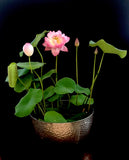The Lotus, Nelumbo nucifera

The Sacred Lotus
A symbol of purity, wisdom, and spiritual growth, the lotus is a treasured plant steeped in ancient history and is often called the Sacred Lotus. Delicate flowers in shades of red, pink, violet, yellow and creamy white are displayed on single stalks amid lush round leaves of deepest green making the lotus one of the most spectacular plants in the aquatic environment. Their almost magical ability to roll away any mud or dust allows them to present an ever-clean fresh face for the world to see. This quality is known as 'the lotus effect'. Their ability to self-regulate the temperature within the flower allows them to survive even during the most stressful temperature extremes, keeping the bud warm during cold nights and cool during hot days.
The lotus belongs to the Nymphaeaceae family and the genus Nelumbo. There are only two species in this genus: Nelumbo nucifera Gaertn in Asia and Oceania, and Nelumbo lutea in North and South America.
Nelumbo nucifera Gaertn is a perennial water plant that is grown in Asian countries both as an ornamental and for its edible rhizomes and seeds. Almost every part of the lotus can be eaten and it considered a starchy staple in Asian diets. In the United States, it is primarily grown for ornamental purposes.
A lotus forms thick rhizomes, or tubers, in the bottom of pots, ponds or slow-moving water. These tubers form in sections called nodes. The joining of two nodes is called an internode. Growth tips for leaves and flowers as well as the true roots, tiny hair-like projections, will grow from the internode. Notice the pointed growth tips in the picture below. They are very fragile, and care should be taken not to break them.
A symbol of purity, wisdom, and spiritual growth, the lotus is a treasured plant steeped in ancient history and is often called the Sacred Lotus. Delicate flowers in shades of red, pink, violet, yellow and creamy white are displayed on single stalks amid lush round leaves of deepest green making the lotus one of the most spectacular plants in the aquatic environment. Their almost magical ability to roll away any mud or dust allows them to present an ever-clean fresh face for the world to see. This quality is known as 'the lotus effect'. Their ability to self-regulate the temperature within the flower allows them to survive even during the most stressful temperature extremes, keeping the bud warm during cold nights and cool during hot days.
The lotus belongs to the Nymphaeaceae family and the genus Nelumbo. There are only two species in this genus: Nelumbo nucifera Gaertn in Asia and Oceania, and Nelumbo lutea in North and South America.
Nelumbo nucifera Gaertn is a perennial water plant that is grown in Asian countries both as an ornamental and for its edible rhizomes and seeds. Almost every part of the lotus can be eaten and it considered a starchy staple in Asian diets. In the United States, it is primarily grown for ornamental purposes.
A lotus forms thick rhizomes, or tubers, in the bottom of pots, ponds or slow-moving water. These tubers form in sections called nodes. The joining of two nodes is called an internode. Growth tips for leaves and flowers as well as the true roots, tiny hair-like projections, will grow from the internode. Notice the pointed growth tips in the picture below. They are very fragile, and care should be taken not to break them.

Notice the pointed growth tips growing
from the nodes of the lotus tubers
Large, round leaves are held above water on thin, prickly stems. In shallow waters, depending on the cultivars, the leaves may rise several feet above the water while the leaves of smaller cultivars grown in bowls may be only inches high. These miniature cultivars are treasured by the Chinese and are called the “exquisites” of bowl lotus, teacup or micro lotus.

Mangala patum
Hybridized by Dr. Nopchai Chansilpa
How long does a lotus live?
The plant completes a cycle in less than a year. The active growing season requires about 4-6 months for the tuber to bud, leaf out, flower, fruit, form a rhizome, mature and return to dormancy.
